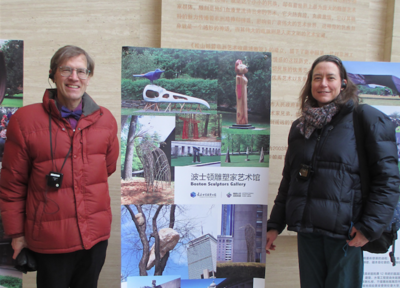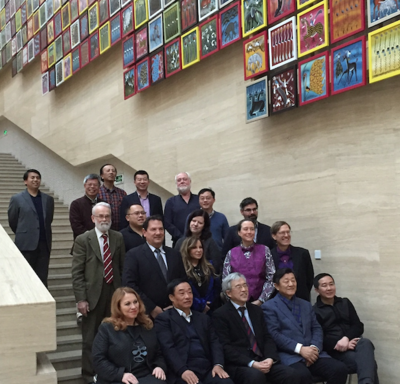Discussing the International Sculpture Parks Union Conference

Andy Moerlein and Donna Dodson. Photo courtesy Donna Dodson.
By Olivia J. Kiers
Sculptors Donna Dodson and Andy Moerlein represented the Boston Sculptors Gallery at the International Sculpture Parks Union’s (ISPU) first plenary meeting in Changchun, China from January 10–12. While there, they joined fellow attendees in a tour of the Changchun World Sculpture Park, the largest of its kind in the world. ANE Portfolio discusses the conference with Dodson and Moerlein:
ANE: You both have a history of participating in residencies abroad; how has working internationally affected your practice? Was this your first time in China?
Dodson: Working internationally, whether…alongside artists from other countries in the U.S. or making work abroad, is a window into the personal experiences of other artists, in addition to the cultural exchange… It makes you aware of everything, from the different chemistry of art materials in different countries, to the impact of language barriers or the behavior of the Internet.
Moerlein: [It] is both humbling and a confidence builder… My own work becomes more daring and draws upon traditions and ideas I was exposed to. This was [our] first—and very short—visit to China, but…seeing contemporary art that is directly influenced by China’s age-old traditions of brush and landscape—yet so completely new—was inspiring.

ISPU attendees. Photo courtesy Donna Dodson.
ANE: Given that the ISPU was born in Changchun, what are your thoughts on China’s role in the contemporary art world, especially with regard to sculpture parks?
Moerlein: China was huge in the initiation of [ISPU]. The support they gave…is impossible to imagine in the U.S. I am only a little cautious about their impressive power at the moment because next year the ISPU will meet in Switzerland, home of the new president Gertrud Aeschlimann… I am confident she will work hard to truly internationalize the organization… China’s influence on the union was never discussed at the conference. Their organizational force was notably overwhelming, and it is evident the interest they have in shaping this union and gaining value from their investment. The ideas shared for international sculpture parks were beautifully presented by real visionaries who… see art as a legacy for all humanity’s future.
Dodson: In terms of China’s role in the international contemporary art world, I think…there is a feeling that Chinese collectors should buy Chinese artists. It is clear that China has the ambition to compete on a global level in the art world in every capacity… However, being a communist country that celebrates ideals of peace, harmony, [and] joy, a lot of the art compromises its aesthetic value in the service of its message. That was one of the challenges that was discussed.

L to R: Gertrud Aeschlimann, Michael Manjarris, Andy Moerlein, Carole Feuerman and Gary Garrido Schneider in front of Friendship, Peace and Spring. Photo courtesy Donna Dodson.
ANE: Could you describe your experience touring the Changchun World Sculpture Park?
Dodson: We toured the Changchun Sculpture Park on a tram with headphones and a translator. We saw a lot of large-scale, permanent work made by artists from all over the world. In the center is a monumental sculpture, Friendship, Peace, and Spring, [featuring] three figures and other symbolic imagery. You could argue that this style is similar to the narrative, allegorical compositions of Saint-Gaudens or Daniel Chester French. They also have a collection of eight or ten monumental bronze pieces by Rodin at the entrance. [It] seems odd to feature western art at the entrance to a Chinese sculpture park, but very pertinent to modern art history and sculpture.
Moerlein: It was overwhelming. The work was uniformly professional… It was perhaps a bit weighted towards figurative and stylized, but there was enough contemporary, abstract and compelling imagery that it felt like any group show of the best from every country.
Dodson: The fashion students at a local university had a project where they had to design garments for the sculptures in the park. It was really humorous to see the sculpture dressed in modern fashion statements. It underscores the feeling that art is a visible part of culture—its existence is a given.
ANE: What does it mean for the Boston Sculptors Gallery to be a new member of the ISPU?
Moerlein: Boston Sculptors Gallery has a real responsibility to prove our appropriateness in this union. Unlike most members of the ISPU, we do not have an identified place. We [are] a collective with a firm identity and we have created/invented/discovered/inspired places for our work… We see this as a unique model that has real value for freeing art from the constraints of commercial prejudice.
Dodson: Many of our artists have made work at sculpture symposia in China and have contributed monumental public works of art to the Olympic Stadium in Beijing. Our members work on a global stage.
Moerlein: We want public sculpture to be recognized internationally as a vital part of New England synergy.
…………
This is the first installment of ANE Portfolio’s series, “China and the Contemporary Arts in New England.” Please visit next week for a discussion with artist Mark Cooper on his Beijing exhibition, YuYu China Blue.
